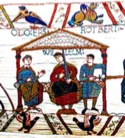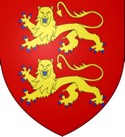Clayton - Person Sheet
Clayton - Person Sheet
Misc. Notes
Herleva also known as Herleve, Arlette, Arletta , Arlotte, and Harlette had three sons – William I of England, who was fathered by Robert I, Duke of Normandy, and Odo of Bayeux and Robert, Count of Mortain, who were both fathered by Herluin de Conteville. All became prominent in William's realm.
Spouses
1MORITON, Sir Robert I 
 , 32G Grandfather
, 32G Grandfather

 , 32G Grandfather
, 32G GrandfatherBirth Date22 Jun 1000
Birth PlaceNormandie, France
OccupationDuke of Normandy
Death Date2 Jul 1035 Age: 35
Death PlaceNicaea, Bithynia, Turkey
Memoon a Pilgrimage to Jerusalem
FlagsNobility
FatherMORITON, Sir Richard II (958-1026)
MotherNORMANDY, Duchess Judith of (982-1017)
Misc. Notes
He was the son of Richard II of Normandy and Judith, daughter of Conan I, Duke of Brittany. Before he died, Richard II had decided his elder son Richard III would succeed him while his second son Robert would became Count of Hiémois. In August of 1026 their father, Richard II, died and Richard III became duke, but very soon afterwards Robert rebelled against his brother, was subsequently defeated and forced to swear fealty to his older brother Richard.
Early reign
When Richard III died a year later there were suspicions that Robert had something to do with his brother's death and although nothing can be proved Robert had most to gain. But the civil war Robert I had brought against his brother Richard III was still causing instability in the duchy. Private wars between neighboring barons raged resulting in a new aristocracy which rose in Normandy during Robert’s reign. It was also during this time that many of the lesser nobility left Normandy to seek their fortunes in southern Italy and elsewhere. Soon after assuming the dukedom, however, possibly in revenge for supporting his brother against him, Robert I assembled an army against his uncle, Robert, Archbishop of Rouen and count of Everux. Only a temporary truce allowed his uncle to leave Normandy in exile but with an edict of excommunication placed on all of Normandy, which was only lifted when Archbishop Robert was allowed to return and his countship was restored. Robert also attacked another powerful churchman, his cousin Hugo III. d'Ivry, Bishop of Bayeux, banishing him from Normandy for an extended period of time. Robert also seized a number of church properties belonging to the abbey of Fecamp.
Outside of Normandy
Despite his domestic troubles Robert decided to intervene in the civil war in Flanders between Baldwin V, Count of Flanders and his father Baldwin IV whom the younger Baldwin had driven out of Flanders. Baldwin V, supported by king Robert II of France, his father-in-law, was persuaded to make peace with his father in 1030 when Duke Robert promised the elder Baldwin his considerable military support. Robert gave shelter to Henry I of France against his mother, Queen Constance, who favored her younger son Robert to succeed to the French throne after his father Robert II. For his help Henry I rewarded Robert with the French Vexin. In the early 1030s Alan III, Duke of Brittany began expanding his influence from the area of Rennes and appeared to have designs on the area surrounding Mont Saint-Michel[9] After sacking Dol and repelling Alan's attempts to raid Avranches, Robert mounted a major campaign against his cousin Alan III. However, Alan appealed to their uncle, Archbishop Robert of Rouen, who then brokered a peace between Duke Robert and his vassal Alan III. His cousins, the Athelings Edward and Alfred, sons of his aunt Emma of Normandy and Athelred, King of England had been living at the Norman Court and at one point Robert, on their behalf, attempted to mount an invasion of England but was prevented in doing so, it was said, by unfavorable winds. Gesta Normannorum Ducum stated that King Cnut sent envoys to Duke Robert offering to settle half the Kingdom of England on Edward and Alfred. After postponing the naval invasion he chose to also postpone the decision until after he returned from Jerusalem.
The Church and his pilgrimage
Robert's attitude towards the Church had changed noticeably certainly since his reinstating his uncle's position as Archbiship of Rouen. In his attempt to reconcile his differences with the Church he restored property that he or his vassals had confiscated, and by 1034 had returned all the properties he had earlier taken from the abbey of Fecamp.
After making his illegitimate son William his heir, he set out on pilgrimage to Jerusalem. According to the Gesta Normannorum Ducum he travelled by way of Constantinople, reached Jerusalem, fell seriously ill and died on the return journey at Nicaea on 2 July 1035. His son William, aged about eight, succeeded him.
According to the historian William of Malmesbury, decades later his son William sent a mission to Constantinople and Nicaea, charging it with bringing his father's body back to be buried in Normandy. Permission was granted, but, having travelled as far as Apulia (Italy) on the return journey, the envoys learned that William himself had meanwhile died. They then decided to re-inter Robert's body in Italy.
Early reign
When Richard III died a year later there were suspicions that Robert had something to do with his brother's death and although nothing can be proved Robert had most to gain. But the civil war Robert I had brought against his brother Richard III was still causing instability in the duchy. Private wars between neighboring barons raged resulting in a new aristocracy which rose in Normandy during Robert’s reign. It was also during this time that many of the lesser nobility left Normandy to seek their fortunes in southern Italy and elsewhere. Soon after assuming the dukedom, however, possibly in revenge for supporting his brother against him, Robert I assembled an army against his uncle, Robert, Archbishop of Rouen and count of Everux. Only a temporary truce allowed his uncle to leave Normandy in exile but with an edict of excommunication placed on all of Normandy, which was only lifted when Archbishop Robert was allowed to return and his countship was restored. Robert also attacked another powerful churchman, his cousin Hugo III. d'Ivry, Bishop of Bayeux, banishing him from Normandy for an extended period of time. Robert also seized a number of church properties belonging to the abbey of Fecamp.
Outside of Normandy
Despite his domestic troubles Robert decided to intervene in the civil war in Flanders between Baldwin V, Count of Flanders and his father Baldwin IV whom the younger Baldwin had driven out of Flanders. Baldwin V, supported by king Robert II of France, his father-in-law, was persuaded to make peace with his father in 1030 when Duke Robert promised the elder Baldwin his considerable military support. Robert gave shelter to Henry I of France against his mother, Queen Constance, who favored her younger son Robert to succeed to the French throne after his father Robert II. For his help Henry I rewarded Robert with the French Vexin. In the early 1030s Alan III, Duke of Brittany began expanding his influence from the area of Rennes and appeared to have designs on the area surrounding Mont Saint-Michel[9] After sacking Dol and repelling Alan's attempts to raid Avranches, Robert mounted a major campaign against his cousin Alan III. However, Alan appealed to their uncle, Archbishop Robert of Rouen, who then brokered a peace between Duke Robert and his vassal Alan III. His cousins, the Athelings Edward and Alfred, sons of his aunt Emma of Normandy and Athelred, King of England had been living at the Norman Court and at one point Robert, on their behalf, attempted to mount an invasion of England but was prevented in doing so, it was said, by unfavorable winds. Gesta Normannorum Ducum stated that King Cnut sent envoys to Duke Robert offering to settle half the Kingdom of England on Edward and Alfred. After postponing the naval invasion he chose to also postpone the decision until after he returned from Jerusalem.
The Church and his pilgrimage
Robert's attitude towards the Church had changed noticeably certainly since his reinstating his uncle's position as Archbiship of Rouen. In his attempt to reconcile his differences with the Church he restored property that he or his vassals had confiscated, and by 1034 had returned all the properties he had earlier taken from the abbey of Fecamp.
After making his illegitimate son William his heir, he set out on pilgrimage to Jerusalem. According to the Gesta Normannorum Ducum he travelled by way of Constantinople, reached Jerusalem, fell seriously ill and died on the return journey at Nicaea on 2 July 1035. His son William, aged about eight, succeeded him.
According to the historian William of Malmesbury, decades later his son William sent a mission to Constantinople and Nicaea, charging it with bringing his father's body back to be buried in Normandy. Permission was granted, but, having travelled as far as Apulia (Italy) on the return journey, the envoys learned that William himself had meanwhile died. They then decided to re-inter Robert's body in Italy.
ChildrenWilliam (Illegitimate) (1024-1087)


